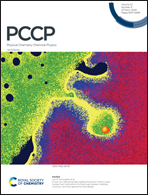Interplay among work function, electronic structure and stoichiometry in nanostructured VOx films†
Abstract
The work function is the parameter of greatest interest in many technological applications involving charge exchange mechanisms at the surface. The possibility to produce samples with a controlled work function is then particularly interesting, albeit challenging. We synthetized nanostructured vanadium oxide films by a room temperature supersonic cluster beam deposition method, obtaining samples with tunable stoichiometry and work function (3.7–7 eV). We present an investigation of the electronic structure of several vanadium oxide films as a function of the oxygen content via in situ Auger, valence-band photoemission spectroscopy and work function measurements. The experiments probed the partial 3d density of states, highlighting the presence of strong V 3d–O 2p and V 3d–V 4s hybridizations which influence 3d occupation. We show how controlling the stoichiometry of the sample implies control over work function, and that the access to nanoscale quantum confinement can be exploited to increase the work function of the sample relative to the bulk analogue. In general, the knowledge of the interplay among work function, electronic structure, and stoichiometry is strategic to match nanostructured oxides to their target applications.



 Please wait while we load your content...
Please wait while we load your content...